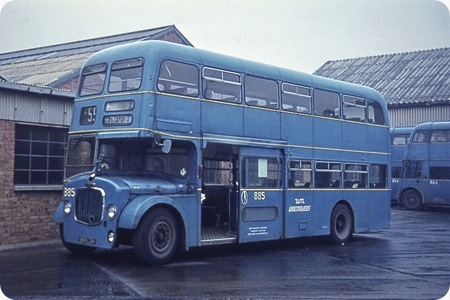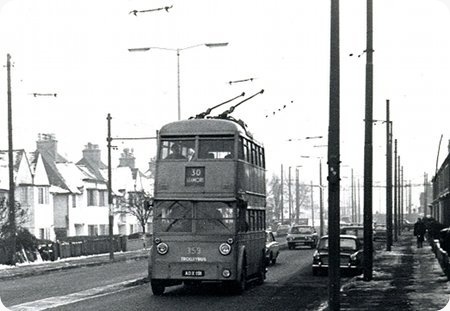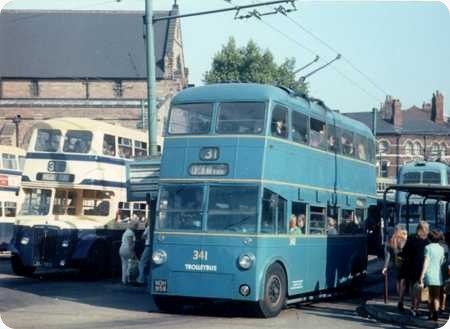WMPTE ex-Walsall Corporation - Dennis Loline - 885 LDH - 885
WMPTE/ex-Walsall Corporation
1960
Dennis Loline II YF10
Willowbrook H44/30F
On 1st October 1969 the Corporation bus fleets of Birmingham, West Bromwich, Walsall and Wolverhampton
were absorbed into the newly formed West Midlands Passenger Transport Executive.
Due largely to
the famously eclectic tastes of its innovative and renowned former General Manager, Mr. R. Edgley Cox,
members of the Walsall fleet were varied and interesting, if not (in my opinion) always very attractive.
This photo of a former Walsall bus was taken in late 1970 on an enthusiasts’ visit. It shows a
Dennis Loline II with Willowbrook H44/30F body, new in 1960.
Photograph and Copy contributed by John Stringer
09/03/14 - 16:27
Walsall buses are intriguing. Always seems to be great attention to detail. I remember being struck by them when visiting for a job in the 60s. I assume that the 3 indentations on the front upper corner are accidental, but what is the cowl or cover above the bonnet/radiator on the nearside front and the access flap around the corner on the nearside? Did Mr Cave Brown Cave have a competitor?
Joe
17/03/14 - 07:42
Dennis used completely different chassis designations for the Loline I and II
in comparison with the later Loline III. Although the sales literature originally included the
Dennis 8 litre 120 bhp engine as an option, in practice no Lolines were built with this power plant.
Corrections and additions to the notes below would be welcome.
Y1 This was used for all Loline
I models, 30ft long with rear entrances and conventionally sprung rear axles. The two for Leigh were
powered by Gardner 6LX engines, but all others had the 6LW engine. The biggest batch went to
Aldershot and District who specified the five speed gearbox, which was the standard fitment. Those
for Leigh, Lancashire United and Middlesborough had four speed gearboxes.
YF1 All Loline IIs
were 30ft long except where shown otherwise. The ‘F’ indicated front entrance. Designation YF1
was applied to the Walsall example 600 DDH that was effectively the Loline II prototype. It had a
Gardner 6LW engine, a Dennis (five speed?) constant mesh gearbox and a conventionally sprung rear
axle.
YF2 The production Walsall model, similar in specification to the prototype, but this,
and all subsequent Loline IIs, had air suspension for the rear axle.
YF3 North Western batch
with Leyland O600 engine and Dennis (five speed?) gearbox.
YF4 As YF3, but with de-rated
Gardner 6LX engine (some sources suggest that the engine was the 6LW, but Dennis expert Robin Hannay
confirms the 6LX).
YF5 Version for Luton, 27ft 8ins long with Leyland O600 engine and Dennis
four speed gearbox.
YF6 The Middlesborough batch, Gardner 6LW engine and four speed gearbox.
YF7 These City of Oxford buses were 27ft 8ins long and were powered by AEC AV 470 engines
through five speed gearboxes.
YF8 Not used. Was it a cancelled order, perhaps?
YF9 This
emerged as the Loline III demonstrator, EPG 179B, with the new chassis designation L3AF1E1. Powered
by a Gardner 6LX engine through a four speed semi automatic SCG gearbox, it was originally intended
for the China Motor Bus Company, but it has been said that it never got there for reasons that are
still obscure.
YF10 The final Walsall machine, shown in John’s picture above, was given this
designation, though the differences from the earlier batch are unclear.
YF11 This is the very
well known, unique, lowbridge Barton machine, equipped with a Leyland O600 engine and a five speed
gearbox. In later life it suffered the supreme indignity of being fitted with an AEC radiator grille
of the Regent Mk V variety. I believe (and fervently hope) that this injustice has since been
righted in preservation.
The first two production Loline III buses went to Leigh Corporation,
and, because these were of rear entrance layout, Dennis rather surprisingly gave them the chassis
designation Y2 consistent with the early Y1 Mark I series. All other Loline IIIs had front entrances
and were given L3 type chassis codes.
Roger Cox
Quick links to the - Comments Page - Contact Page - Home Page



